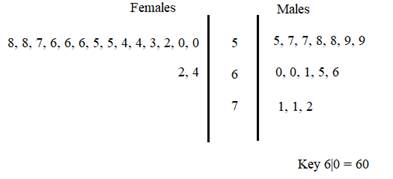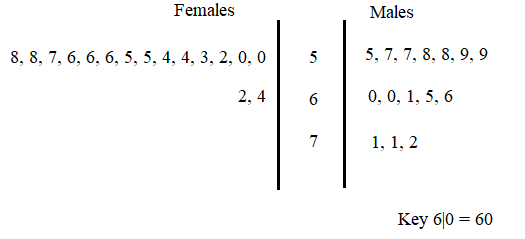
To plot: The back-to-back stem plot for the data of heights (in inches) of the members in the class to compare male heights with female heights.
The back-to-back stem plot of the collected data is shown below

Concept used:
The back-to-back stem plot is used to display a distribution in the graphical form of stem and leaves to compare two data distributions and study their shape.
Calculation:
The data collected the heights (in inches) for 15 male and 15 female students as shown below
| Female | 50 | 50 | 52 | 53 | 54 | 54 | 55 | 55 | 56 | 56 | 57 | 58 | 58 | 62 | 64 |
| Male | 55 | 57 | 57 | 58 | 58 | 59 | 59 | 60 | 60 | 61 | 65 | 66 | 71 | 71 | 72 |
The values collected, heights (in inches) of 15 female students range between 50 to 64 inches, and the heights of male students range between 55 to 72 inches. The leaf takes the unit’s place and the digit in ten’s place is written in the stem. For example, the key is
The back-to-back stem and leaf plot for the collected data is shown below

Interpretation:With reference to the back-to-back stem plot, the data is skewed to the right for both heights of male students and also female students. The heights of male students are a little higher when compared to female student’s height. Most of the female student’s heights are in the range of 50 to 64 inches, whereas male student’s heights are in the range of 55 to 72 inches. There are no outliers in the collected data, and it suggests that there are no abnormal heights among the class students.
Chapter 10 Solutions
PRECALCULUS:GRAPHICAL,...-NASTA ED.
 Calculus: Early TranscendentalsCalculusISBN:9781285741550Author:James StewartPublisher:Cengage Learning
Calculus: Early TranscendentalsCalculusISBN:9781285741550Author:James StewartPublisher:Cengage Learning Thomas' Calculus (14th Edition)CalculusISBN:9780134438986Author:Joel R. Hass, Christopher E. Heil, Maurice D. WeirPublisher:PEARSON
Thomas' Calculus (14th Edition)CalculusISBN:9780134438986Author:Joel R. Hass, Christopher E. Heil, Maurice D. WeirPublisher:PEARSON Calculus: Early Transcendentals (3rd Edition)CalculusISBN:9780134763644Author:William L. Briggs, Lyle Cochran, Bernard Gillett, Eric SchulzPublisher:PEARSON
Calculus: Early Transcendentals (3rd Edition)CalculusISBN:9780134763644Author:William L. Briggs, Lyle Cochran, Bernard Gillett, Eric SchulzPublisher:PEARSON Calculus: Early TranscendentalsCalculusISBN:9781319050740Author:Jon Rogawski, Colin Adams, Robert FranzosaPublisher:W. H. Freeman
Calculus: Early TranscendentalsCalculusISBN:9781319050740Author:Jon Rogawski, Colin Adams, Robert FranzosaPublisher:W. H. Freeman
 Calculus: Early Transcendental FunctionsCalculusISBN:9781337552516Author:Ron Larson, Bruce H. EdwardsPublisher:Cengage Learning
Calculus: Early Transcendental FunctionsCalculusISBN:9781337552516Author:Ron Larson, Bruce H. EdwardsPublisher:Cengage Learning





